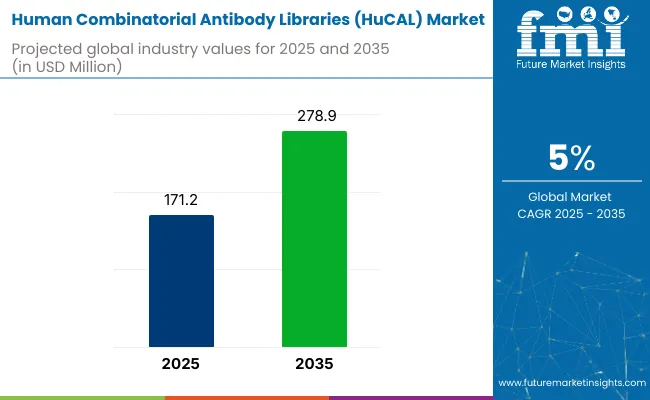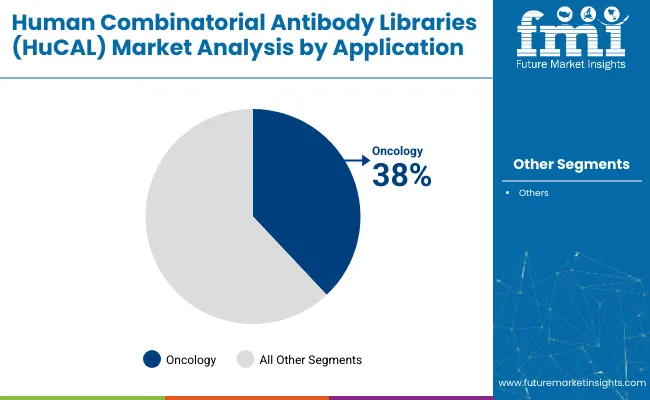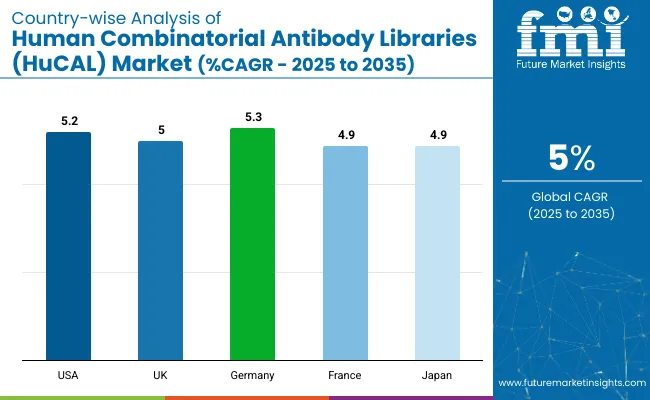The global human combinatorial antibody libraries (HuCAL) market is valued at USD 171.2 million in 2025 and is projected to reach USD 278.9 million by 2035, growing at a CAGR of 5%. Market growth is anticipated to be driven by the increased adoption of antibody-based therapeutics, particularly in personalized medicine, oncology, and autoimmune disorders.

| Metric | Value |
|---|---|
| Market Size (2025) | USD 171.2 Million |
| Market Value (2035) | USD 278.9 Million |
| CAGR (2025 to 2035) | 5% |
As the demand for high-affinity, human-origin antibodies continues to rise, HuCAL technology is being increasingly preferred for its speed, precision, and reduced immunogenicity. Technology improvements such as AI-based antibody modeling, CRISPR-driven affinity maturation, and phage display screening are being integrated into HuCAL workflows to accelerate timelines and improve therapeutic outcomes.
Simultaneously, cloud-based structural modeling platforms and decentralized antibody libraries are being utilized to increase scalability and accessibility across research and commercial pipelines. These innovations are enabling more precise and efficient antibody discovery, reducing development costs, and fostering collaboration across global research teams.
Global regulatory agencies, including the FDA and EMA, have enforced stricter standards related to safety, traceability, and ethical engineering of recombinant antibodies, which in turn has enhanced the credibility and adoption of HuCAL solutions.
In Asia, government funding and infrastructure expansion have been encouraged, especially in China, Japan, and South Korea, to boost domestic antibody development capabilities and reduce reliance on imported biologics. These efforts are driving innovation in antibody therapeutics, supporting local industries, and positioning these countries as key players in the global biologics market, contributing to advancements in precision medicine and targeted therapies.
The USA is expected to be one of the fastest-growing markets for human combinatorial antibody libraries, with a CAGR of 5.2% from 2025 to 2035. The pharmaceutical and biotechnology companies segment is projected to dominate the end-user category, capturing 42% of the market share in 2025.
Oncology will lead the application segment with a 38% share, driven by the growing demand for precision therapies and antibody-based cancer treatments. Significant expansion is also forecasted in key international markets, with Germany projected to record steady CAGR of 5.3%.
The market is segmented into application, end user, and region. By application, the market is divided into oncology, neurosciences, stem cells, and immunology. Based on end user, the market is categorized into pharmaceutical and biotechnology companies, diagnostic labs, and research and academic institutes. Regionally, the market is classified into North America, Latin America, Western Europe, Eastern Europe, East Asia, South Asia Pacific, and Middle East and Africa.
Oncology is projected to lead the application segment, accounting for 38% of the global market share by 2025. This segment has been favored due to the increasing use of antibody-based therapies in cancer treatment, particularly for their ability to deliver precision targeting and reduced immunogenicity.

Pharmaceutical and biotechnology companies are expected to lead the end-user segment, capturing 42% of the global market share by 2025. Their dominance has been attributed to strong investment in HuCAL platforms for therapeutic antibody discovery and development.

The human combinatorial antibody libraries market is experiencing consistent growth, driven by the rising adoption of targeted biologics, increasing focus on personalized medicine, and continuous integration of AI-driven antibody discovery platforms. Rapid advancements in recombinant antibody engineering and phage display technologies have been contributing to accelerated drug development timelines and improved therapeutic precision.
Recent Trends in the Human Combinatorial Antibody Libraries Market
Challenges in the Human Combinatorial Antibody Libraries Market

The USA human combinatorial antibody libraries market is expected to grow at a CAGR of 5.2% from 2025 to 2035. Growth is being driven by strong investments in antibody-based drug discovery, an expanding personalized medicine ecosystem, and the presence of leading biopharmaceutical firms actively applying HuCAL technology for oncology and immunotherapy.
The UK human combinatorial antibody libraries market is projected to expand at a 5% CAGR during the study period. Accelerated by academic-biotech collaboration and the nation’s leadership in clinical trials and immunotherapy research, demand for fully human antibodies is steadily advancing.
Germany’s human combinatorial antibody libraries market is forecasted to grow at a CAGR of 5.3% between 2025 and 2035. As a European leader in recombinant antibody engineering, the country has been emphasizing translational medicine and therapeutic antibody innovation through institutional and industrial collaboration.
France’s human combinatorial antibody libraries market is anticipated to grow at a CAGR of 4.9% from 2025 to 2035. A growing focus on biopharmaceutical development, along with regulatory support for recombinant therapies, is contributing to widespread HuCAL adoption in therapeutic research and biosimilar innovation.
Japan’s human combinatorial antibody libraries market is projected to expand at a CAGR of 4.9% from 2025 to 2035. With a high focus on regenerative and personalized medicine, the country has adopted HuCAL technology across antibody discovery pipelines for oncology, neurology, and rare diseases.
The human combinatorial antibody libraries market is moderately consolidated, with key global firms maintaining significant market shares while emerging and specialized biotechnology companies continue to drive innovation. Competitive dynamics are being shaped by advancements in antibody engineering, licensing of proprietary HuCAL platforms, AI-powered discovery technologies, and strategic alliances across pharmaceutical and academic ecosystems.
Tier-one developers, such as Bio-Rad, MorphoSys, and Taurus Biosciences, are competing through investments in automated antibody screening platforms, custom therapeutic antibody solutions, and expanded application of HuCAL in oncology and autoimmune disease research. These companies have been forming partnerships with CROs, academic institutions, and pharmaceutical giants to strengthen drug discovery capabilities and ensure accelerated clinical translation.
Recent Human Combinatorial Antibody Libraries Industry News
| Report Attributes | Details |
|---|---|
| Market Size (2025) | USD 171.2 Million |
| Projected Market Size (2035) | USD 278.9 Million |
| CAGR (2025 to 2035) | 5% |
| Base Year for Estimation | 2024 |
| Historical Period | 2020 to 2024 |
| Projections Period | 2025 to 2035 |
| Report Parameters | Revenue in USD millions |
| Application Analyzed | Oncology, Neurosciences, Stem Cells, and Immunology |
| End User Analyzed | Pharmaceutical & Biotechnology Companies, Diagnostic Labs, and Research & Academic Institutes |
| Regions Covered | North America, Latin America, Western Europe, Eastern Europe, East Asia, South Asia Pacific, Middle East and Africa |
| Countries Covered | United States, Canada, United Kingdom, Germany, France, China, Japan, South Korea, Brazil, Australia |
| Key Players | Bio-Rad, MorphoSys, Taurus Biosciences, AbD Serotec, Creative Biolabs, Absolute Antibody Ltd., Innovagen AB, Genscript Biotech |
| Additional Attributes | Dollar sales by value, market share analysis by region, and country-wise analysis |
The human combinatorial antibody libraries market is valued at USD 171.2 million in 2025.
The market is forecasted to reach USD 278.9 million by 2035, reflecting a CAGR of 5%.
Oncology is expected to lead the application segment with a 38% market share in 2025.
Pharmaceutical and biotechnology companies will dominate the end-user segment, with a 42% market share in 2025.
Western Europe is anticipated to be the fastest-growing region, with Germany expanding at a CAGR of 5.3% from 2025 to 2035.






Full Research Suite comprises of:
Market outlook & trends analysis
Interviews & case studies
Strategic recommendations
Vendor profiles & capabilities analysis
5-year forecasts
8 regions and 60+ country-level data splits
Market segment data splits
12 months of continuous data updates
DELIVERED AS:
PDF EXCEL ONLINE
Human Papilloma Virus Testing Market Size and Share Forecast Outlook 2025 to 2035
Human-Centric Lighting Market Size and Share Forecast Outlook 2025 to 2035
Human Identification Market Size and Share Forecast Outlook 2025 to 2035
Human Immunodeficiency Virus Type 1 (HIV 1) Market Size and Share Forecast Outlook 2025 to 2035
Humanoid Robot Market Size and Share Forecast Outlook 2025 to 2035
Humanized Mouse Model Market Size and Share Forecast Outlook 2025 to 2035
Human Milk Oligosaccharides Market Analysis - Size, Share, and Forecast Outlook 2025 to 2035
Human Growth Hormone (HGH) Treatment and Drugs Market Trends - Growth & Forecast 2025 to 2035
Human Augmentation Technology Market Growth - Trends & Forecast 2025 to 2035
Key Companies & Market Share in the Human Milk Oligosaccharides Sector
Human RSV Treatment Market Insights - Innovations & Forecast 2025 to 2035
Human Osteoblasts Market – Growth & Forecast 2024-2034
Human Capital Management Market
Human Anatomical Models Market
Human Machine Interface Market
UK Human Milk Oligosaccharides Market Trends – Size, Demand & Forecast 2025-2035
USA Human Milk Oligosaccharides Market Insights – Growth & Demand 2025-2035
ASEAN Human Milk Oligosaccharides Market Report – Size, Demand & Growth 2025–2035
Europe Human Milk Oligosaccharides Market Growth – Trends, Demand & Innovations 2025-2035
Australia Human Milk Oligosaccharides Market Analysis – Size & Industry Trends 2025-2035

Thank you!
You will receive an email from our Business Development Manager. Please be sure to check your SPAM/JUNK folder too.
Chat With
MaRIA